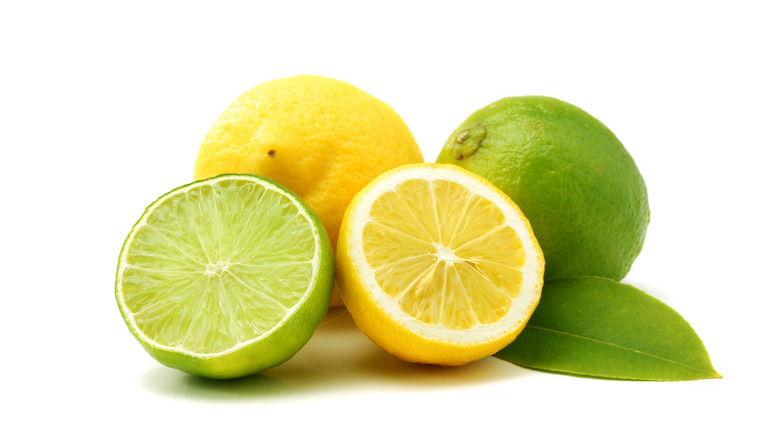How To Determine When To Cook With Lemon Vs. Lime
We all know what to do when life gives us lemons, but what if we get limes instead? How do we determine when to use a lemon or use a lime?
First, think about the differences between lemons and limes. They're similar in that both are citrus fruits, but general distinctions are made based on their color, size, and shape. Lemons are usually yellow, larger, and oblong in shape, while limes are usually green in color, smaller, and rounder in shape. Additionally, the flavor profile of lemons tends to be sweeter, while lime flavors have notes of bitter and sour in them.
Both fruits can be substituted for each other in a pinch. That said, when there is an opportunity to be more discerning, we encourage you to pay special attention to the unique characteristics of each fruit to get the most out of them. Perhaps coincidentally, lemons show up more in cuisines of temperate regions like North America and Europe, and limes are commonly found in more tropical climes like Southeast Asia and Mexico. This gives you a quick shortcut to work with when considering which citrus fruit to use in which dish. Let's dive a little deeper into their different uses.
Lemons are good for more than just lemonade
A lemon's sweet-sour profile makes it a perfect match for many lemon-centric recipes that aren't plain lemonade. Cakes, tarts, pies, and even cookies can showcase the flavors of lemon well, especially when paired with fresh whipped cream to balance the tartness.
The main thing to consider when considering lemony desserts is to make it one of the primary flavors, if not the forefront of your dish. The brightness of lemon works best when it is the star of the show, which is why this citrus fruit is the focal point of popular desserts like lemon bars and lemon curd. Serve these desserts after meals that are heavier in fat, like steaks and burgers, for a satisfying palate cleanser.
Lemons also get their savory moment in the sun, especially in the Levant and North African regions. Lemon juice is often used to cut through the richness of tahini, which is essential when making homemade hummus. Lemons can also be preserved; their peels bring a briny-sour tang to North African tagines, a slow-cooked stew with meats and spices. There are also uses for lemons in the kitchen beyond culinary purposes, like cleaning the microwave or freshening the garbage disposal, as they have a strong — but still pleasant — scent. Just remember not to make some of the most common mistakes with lemons.
When limes belong in the limelight
While lemons are usually what folks think of when it comes to citrus desserts, limes are the ultimate condiment and flavor enhancer of tropical cuisines. Limes are generally more acidic, making them fantastic candidates for adding strong tangy notes to dishes. However, as many kinds are available in the grocery store, you should choose wisely and pick the best limes accordingly.
In Mexican cuisine, limes add essential brightness to various salsas, which, in turn, get added to different dishes. You'll rarely encounter a taco bar without a receptacle full of lime wedges ready to be squeezed over a perfectly assembled taco.
Limes are also squeezed over many Southeast Asian dishes. Key lime wedges are often served alongside fried noodles like Pad Thai and mie goreng, adding a zing to counter spice and fat. Juicy calamansi limes feature heavily in Filipino cuisine, which has a predilection for sour flavors. Leaves from the makrut lime tree are sometimes torn off and cooked into meat dishes, lending a heady citrus scent.
Although less popular for desserts (except key lime pie), limes can also be made into drinks like limeade, which means when life gives you limes instead of lemons, you can still make a refreshing drink!


